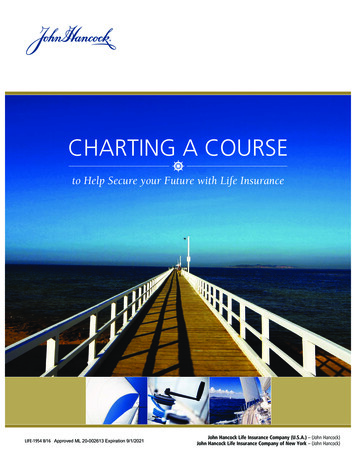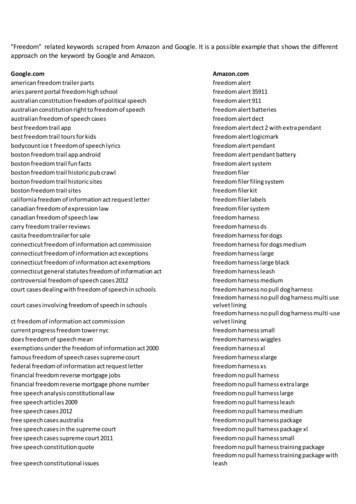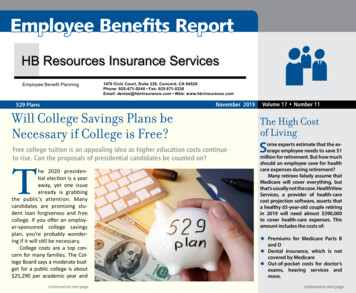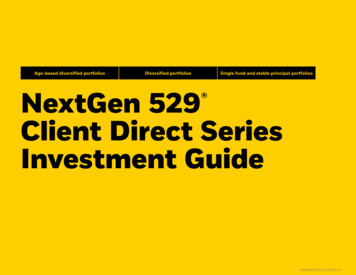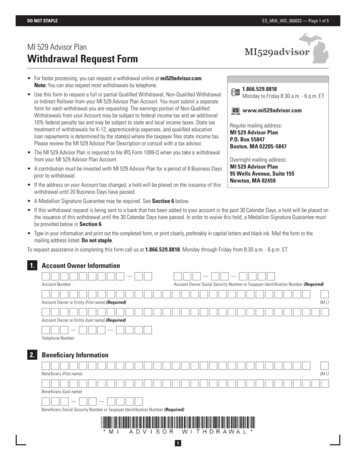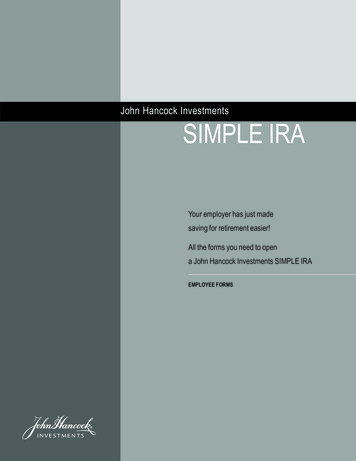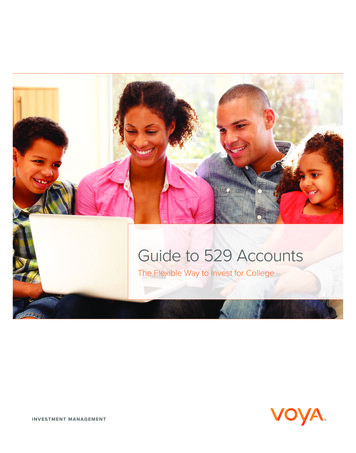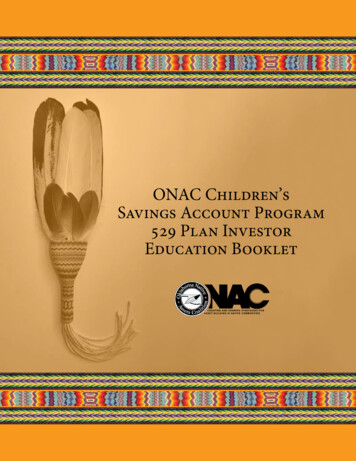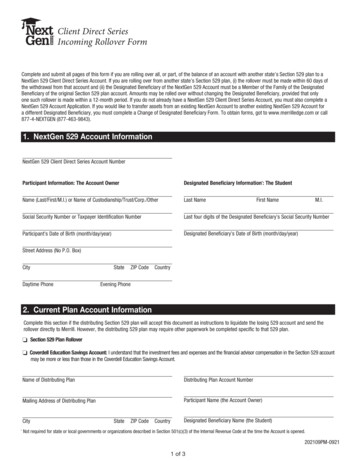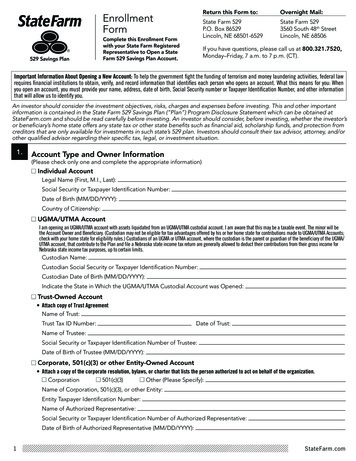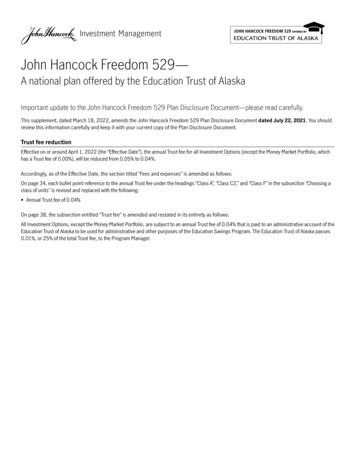
Transcription
John Hancock Freedom 529—A national plan offered by the Education Trust of AlaskaImportant update to the John Hancock Freedom 529 Plan Disclosure Document—please read carefully.This supplement, dated March 18, 2022, amends the John Hancock Freedom 529 Plan Disclosure Document dated July 22, 2021. You shouldreview this information carefully and keep it with your current copy of the Plan Disclosure Document.Trust fee reductionEffective on or around April 1, 2022 (the “Effective Date”), the annual Trust fee for all Investment Options (except the Money Market Portfolio, whichhas a Trust fee of 0.00%), will be reduced from 0.05% to 0.04%.Accordingly, as of the Effective Date, the section titled “Fees and expenses” is amended as follows:On page 34, each bullet point reference to the annual Trust fee under the headings “Class A”, “Class C2,” and “Class F” in the subsection “Choosing aclass of units” is revised and replaced with the following: Annual Trust fee of 0.04%On page 38, the subsection entitled “Trust fee” is amended and restated in its entirety as follows:All Investment Options, except the Money Market Portfolio, are subject to an annual Trust fee of 0.04% that is paid to an administrative account of theEducation Trust of Alaska to be used for administrative and other purposes of the Education Savings Program. The Education Trust of Alaska passes0.01%, or 25% of the total Trust fee, to the Program Manager.
On pages 39, 40, and 41, the tables entitled “Class A cost structure,” “Class C2 cost structure,” and “Class F cost structure” in the subsection“Summary of fees/expenses” are revised and replaced with the following:Summary of fees/expensesFees and expenses vary based on the class of units chosen and the amount invested. A summary of fees by class, inclusive of asset-based fees(including underlying fund expenses) and additional investor expenses, is provided on the following charts.Class A cost structureAnnual asset-based fees ntfeePortfolio 2037–20400.760.25Portfolio 2033–20360.750.25Portfolio 2029–20320.72Portfolio 2025–2028Additional investor expensesTrust feeDistributionandservice feeTotal annualasset-basedfee2 (%)Maximumsalescharge3 (%)AnnualAccountmaintenancefee4 ( .264.00150.680.250.040.251.224.0015Portfolio 2021–20240.570.250.040.251.114.0015Enrollment Portfolio0.540.250.040.251.083.0015American Mutual Portfolio0.640.250.040.251.184.0015Blue Chip Growth Portfolio0.680.250.040.251.224.0015Capital Appreciation Portfolio0.730.250.040.251.274.0015Equity Portfolio0.760.250.040.251.304.0015Equity Income Portfolio0.650.250.040.251.194.0015Fixed Income Portfolio0.620.250.040.151.063.0015Future Trends Portfolio0.810.250.040.251.354.0015International Value Portfolio0.830.250.040.251.374.0015Mid-Cap Value Portfolio0.780.250.040.251.324.0015Multimanager Lifestyle Balanced Fund0.910.250.040.251.454.0015Multimanager Lifestyle Growth Fund0.960.250.040.251.504.0015Multimanager Lifestyle Moderate Fund0.860.250.040.251.404.0015New Horizons Portfolio0.750.250.040.251.294.0015Short Term Bond Portfolio0.400.250.040.150.843.0015Small-Cap Stock Portfolio0.880.250.040.251.424.0015Investment options1 Estimated underlying fund expenses reflect a weighted average of the underlying mutual fund expenses using the target allocations of the underlying mutual fundseffective April 1, 2022, and the actual net expense ratios of the underlying funds as of each fund’s most recent published fiscal year end. Future underlying fund and/orInvestment Option expenses may be higher or lower than those reflected. 2 The total annual asset-based fee is the sum of the annual, estimated underlying fundexpenses, the Program Management fee, the Trust fee, and the distribution and service fee. The total annual asset-based fee is assessed over the course of the yearand does not include sales charges or the Account maintenance fee. For an illustration of the total investment cost of a 10,000 investment over 1-, 3-, 5-, and 10-yearperiods, please refer to the chart on page 5 of this supplement titled “Hypothetical cost of a 10,000 investment.” Future annual asset-based fees may be higher orlower than those reflected. 3 Except for Short-Term Bond Portfolio, Fixed Income Portfolio, and Enrollment Portfolio, Class A units will be subject to a maximum salescharge of 4.00% (3.50% for Grandfathered Accounts invested in Equity Portfolio or Future Trends Portfolio. See page 35 for information on Grandfathered Class AUnits). Short-Term Bond Portfolio, Fixed Income Portfolio, and Enrollment Portfolio’s Class A units will be subject to a maximum sales charge of 3.00%. Certaincontributions may be eligible for breakpoint pricing, thereby reducing the sales charge (see page 35, “Breakpoints and Rights of Accumulation (ROA),” and page 36,“Letter of Intent”) or a sales charge waiver as described on page 36 under “Initial sales charge/fee waivers.” 4 The maximum annual Account maintenance fee is 15;the annual Account maintenance fee may be reduced or waived as described on page 38.2
Class C2 cost structureAnnual asset-based fees (%)Investment optionsPortfolio 2037–2040Portfolio 2033–2036Portfolio 2029–2032Portfolio 2025–2028Portfolio 2021–2024Enrollment PortfolioAmerican Mutual PortfolioBlue Chip Growth PortfolioCapital Appreciation PortfolioEquity PortfolioEquity Income PortfolioFixed Income PortfolioFuture Trends PortfolioInternational Value PortfolioMid-Cap Value PortfolioMultimanager Lifestyle Balanced FundMultimanager Lifestyle Growth FundMultimanager Lifestyle Moderate FundNew Horizons PortfolioShort Term Bond PortfolioSmall-Cap Stock 50.250.250.250.250.250.250.25Additional investor expensesDistributionand servicefee(commencesTrust feein year 01.001.001.000.901.00Totalannualasset-basedfee3 (%)Maximumdeferredsalescharge4 (%)AnnualAccountmaintenance fee5( 515151515151 Estimated underlying fund expenses reflect a weighted average of the underlying mutual fund expenses using the target allocations of the underlying mutual fundseffective April 1, 2022, and the actual net expense ratios of the underlying funds as of each fund’s most recent published fiscal year end. Future underlying fundand/or Investment Option expenses may be higher or lower than those reflected. 2 Reduced to the applicable distribution and service fee for the corresponding Class Aportfolio on or around the 15th day of the month after the 6-year anniversary of the initial purchase, when Class C2 units automatically convert to Class A units.3 The total annual asset-based fee is the sum of the estimated underlying fund expenses, the Program Management fee, the Trust fee, and the distribution and servicefee. The total annual asset-based fee is assessed over the course of the year and does not include sales charges or the Account maintenance fee. For an illustration ofthe total investment cost of a 10,000 investment over 1-, 3-, 5-, and 10-year periods, please refer to the chart on page 5 of this supplement titled “Hypothetical cost ofa 10,000 investment.” Future annual asset-based fees may be higher or lower than those reflected. 4 Class C2 units are not subject to an initial sales charge. 5 Themaximum annual Account maintenance fee is 15; the annual Account maintenance fee may be reduced or waived as described on page 38.3
Class F cost structureAnnual asset-based fees (%)Investment optionsPortfolio 2037–2040Portfolio 2033–2036Portfolio 2029–2032Portfolio 2025–2028Portfolio 2021–2024Enrollment PortfolioAmerican Mutual PortfolioBlue Chip Growth PortfolioCapital Appreciation PortfolioEquity PortfolioEquity Income PortfolioFixed Income PortfolioFuture Trends PortfolioInternational Value PortfolioMid-Cap Value PortfolioMultimanager Lifestyle Balanced FundMultimanager Lifestyle Growth FundMultimanager Lifestyle Moderate FundNew Horizons PortfolioShort Term Bond PortfolioSmall-Cap Stock 50.250.250.250.250.250.250.25Additional investor expensesDistributionand servicefee(commencesTrust feein year 00.000.000.000.000.00Totalannualasset-basedfee3 (%)Maximumdeferredsalescharge2 (%)AnnualAccountmaintenance fee4( 515151515151 Estimated underlying fund expenses reflect a weighted average of the underlying mutual fund expenses using the target allocations of the underlying mutual fundseffective April 1, 2022, and the actual net expense ratios of the underlying funds as of each fund’s most recent published fiscal year end. Future underlying fund and/orInvestment Option expenses may be higher or lower than those reflected. 2 Although Class F units are not subject to an initial sales charge or annual distribution andservice fee, your financial intermediary may charge commissions and/or fees outside of the Plan that are not reflected in the table above. 3 The total annual assetbased fee is the sum of the estimated underlying fund expenses, the Program Management fee, the Trust fee, and the distribution and service fee. The total annualasset-based fee is assessed over the course of the year and does not include sales charges or the Account maintenance fee. For an illustration of the total investmentcost of a 10,000 investment over 1-, 3-, 5-, and 10-year periods, please refer to the chart on page 5 of this supplement, titled “Hypothetical cost of a 10,000investment.” Future annual asset-based fees may be higher or lower than those reflected. 4 The maximum annual Account maintenance fee is 15; the annual Accountmaintenance fee may be reduced or waived as described on page 38.4
On page 43, the subsection “Hypothetical cost of a 10,000 investment” is deleted in its entirety and replaced with the following:The following table compares the approximate cost of investing in the various classes of units offered by John Hancock Freedom 529 overdifferent periods of time. Your actual cost may be higher or lower. The table is based on the following assumptions: A 10,000 investment for the time periods shown A 5% annually compounded rate of return on the net amount invested throughout the period The imposition of the maximum initial sales charge (without regard to possible breakpoints in Class A units) All units are redeemed at the end of the period shown for Qualified Higher Education Expenses, and therefore the table does not consider theimpact, if any, of federal or state taxes or penalties Total annual asset-based fees for each Investment Option are the same as those shown in the previous Summary of fees/expenses tables. Expenses for each Investment Option include the entire annual Account maintenance fee of 15 In the case of the 10-year investment period, the annual costs shown for Class C2 assume the units are converted to Class A in the first monthafter the 6-year anniversary of the initial purchase The actual net expense ratios of the underlying funds (as of each fund’s most recently published prospectus) are reflected for all time periods The annual costs shown for Class F do not reflect any commissions or fees charged directly to clients by financial intermediaries outside ofthe PlanOne yearCost structureThree yearsFive yearsTen yearsAC2FAC2FAC2FAC2FPortfolio 2037–2040Portfolio 2033–2036Portfolio 2029–2032Portfolio 2025–2028Portfolio 2021–2024Enrollment PortfolioAmerican Mutual PortfolioBlue Chip Growth PortfolioCapital Appreciation PortfolioEquity PortfolioEquity Income PortfolioFixed Income PortfolioFuture Trends 482International Value 1,505Mid-Cap Value PortfolioMultimanager Lifestyle Balanced FundMultimanager Lifestyle Growth FundMultimanager Lifestyle Moderate FundNew Horizons PortfolioShort Term Bond PortfolioSmall-Cap Stock PortfolioMoney Market 31,561811Investment options5
Additionally, as of the Effective Date, the section titled “Appendix: underlying mutual funds” is amended as follows:On page 62, the table entitled “Underlying mutual funds expense ratios” is deleted in its entirety and replaced with the following:Underlying mutual funds expense ratios(as of each fund’s most recent published prospectus)%American Mutual Fund0.64John Hancock Capital Appreciation Fund, subadvised by Jennison10.74John Hancock Core Bond Fund, subadvised by Wells Capital0.621John Hancock Disciplined Value Fund, subadvised by Boston Partners0.65John Hancock Disciplined Value International Fund, subadvised by Boston Partners0.84John Hancock Emerging Markets Fund, subadvised by Dimensional1.0311John Hancock International Growth Fund, subadvised by Wellington0.87John Hancock Multimanager Lifestyle Balanced Fund20.91John Hancock Multimanager Lifestyle Growth Fund20.961John Hancock Multimanager Lifestyle Moderate Fund20.86John Hancock Strategic Income Opportunities Fund, subadvised by Manulife Investment Management0.69T. Rowe Price Blue Chip Growth Fund0.681T. Rowe Price Equity Income Fund0.65T. Rowe Price Financial Services Fund0.89T. Rowe Price Health Sciences Fund0.76T. Rowe Price Limited Duration Inflation Focused Bond Fund10.48T. Rowe Price Mid-Cap Growth Fund0.73T. Rowe Price Mid-Cap Value Fund0.78T. Rowe Price New Horizons Fund0.75T. Rowe Price Real Assets Fund0.83T. Rowe Price Science & Technology Fund0.77T. Rowe Price Short-Term Bond Fund0.40T. Rowe Price Small-Cap Stock Fund0.88T. Rowe Price Spectrum Income Fund0.62T. Rowe Price U.S. Treasury Money Fund0.2821 Due to contractual fee waivers or reimbursements, the actual total operating expense for John Hancock Capital Appreciation Fund is 0.73%, John Hancock CoreBond Fund is 0.61%, John Hancock Disciplined Value International Fund is 0.83%, John Hancock Emerging Markets Fund is 1.02%, John Hancock International GrowthFund is 0.86%, John Hancock Strategic Income Opportunities Fund is 0.64%, and the T. Rowe Price Limited Duration Inflation Focused Bond Fund is 0.39%. Thesewaivers or reimbursements may be amended or withdrawn in the future. 2 The figure shown for John Hancock Multimanager Lifestyle Balanced Fund, John HancockMultimanager Lifestyle Growth Fund, John Hancock Multimanager Moderate Fund, and T. Rowe Price Financial Services Fund includes the addition of acquired fund feesand expenses. The funds’ actual expense ratio are 0.21%, 0.21%, 0.22%, and 0.86%, respectively.6
Federal gift and estate tax exclusion increaseThe federal gift tax exclusion limits have increased for 2022. Accordingly, the Plan Disclosure Document is amended as follows:On page 6, in the section titled “Frequently asked questions,” the third bullet under the answer to “What are the benefits of investing in a 529plan?” is amended and restated as follows:Gift and estate tax benefits: The most cost-effective way to pay for a college education is to plan in advance and save diligently. 529 educationsavings plans offer a unique feature that lets you make five years’ worth of contributions in a single year—currently up to 80,000 ( 160,000for couples filing jointly) per Beneficiary—without triggering federal gift taxes. Plus, these gifts help reduce the value of the contributor’s taxableestate, providing potential estate planning advantages.2On page 9, in the section titled “Frequently asked questions,” the answer to “What are the gift and estate tax benefits to an Account?” is amendedand restated as follows:Generally, gifts made to an individual that exceed 16,000 in a single year are subject to the federal gift tax. Within a 529 plan, the five-yearaccelerated gifting provision allows for lump-sum contributions of up to 80,000 ( 160,000 for a married couple) per Beneficiary made in asingle year to be considered as being made ratably over five years to qualify for exclusion from federal gift tax.2On page 52, in the section titled “Tax considerations,” the first paragraph in the subsection “Federal gift and estate taxes” is amended andrestated as follows:Contributions to Accounts are considered completed gifts and, therefore, qualify for federal gift tax exclusions. Generally, a gift of up to 16,000*from a single person ( 32,000 for a married couple) in one year is excluded from federal gift tax. Within a 529 plan, the five-year acceleratedgifting provision allows for lump-sum contributions of up to 80,000* ( 160,000 for a married couple) per Beneficiary made in a single year tobe considered as being made ratably over five years. To take advantage of the five-year accelerated gifting provision, you must file IRS Form 709with your federal tax return for the year the contribution was made. The limits refer to total gifts, including those made outside the Plan, given tothe Beneficiary by the same person during the five-year period.* These exclusion amounts are currently in place for the 2022 tax year. In future years, the amount of the federal gift tax exclusion maybe increased.Investment and Program Management Services updateEffective immediately, the section titled “The Plan’s administrative and legal framework” is amended as follows:On page 58, under the heading “Investment and Program Management Services,” the first paragraph is amended and restated as follows:T. Rowe Price Associates, Inc. is the investment adviser and Program Manager for the Plan. The Plan’s underlying investments are managed byT. Rowe Price Associates, Inc. or its affiliates, or by the third-party investment managers with whom T. Rowe Price has entered into agreements forthe purchase of shares offered by such third-party managers.2 In future years, the amount of the federal gift tax exclusion may be increased. Additionally, If the contributor dies before the end of the five-year gifting period, aprorated portion of the contribution amount will be included in the contributor’s taxable estate.7
John Hancock Freedom 529 is an education savings plan offered by the Education Trust of Alaska, managed by T. Rowe Price, and distributed byJohn Hancock Distributors LLC through other broker-dealers that have a selling agreement with John Hancock Distributors LLC.John Hancock Distributors LLC is a member of FINRA, and is listed with the Municipal Securities Rulemaking Board (MSRB). 2022 John Hancock. All rights reserved. Information included in this material is believed to be accurate as of the printing date.John Hancock Freedom 529P.O. Box 17603, Baltimore, MD 21297-1603, 866-222-7498, jhinvestments.com/529529 PLANS ARE NOT FDIC INSURED, MAY LOSE VALUE, AND ARE NOT BANK OR STATE GUARANTEED.Manulife, Manulife Investment Management, Stylized M Design, and Manulife Investment Management & Stylized M Design are trademarks of The ManufacturersLife Insurance Company and are used by it, and by its affiliates under license.529PDDS1 3/22
Plan Disclosure DocumentJohn HancockFreedom 529July 22, 2021
ii
In this bookletWhere to find important informationFrequently asked questions6Account Holder and Beneficiary requirements14, 15Contribution and distribution limitations and penalties15, 49Investment Options and underlying fund descriptions18, 62Risk factors29Investment performance31Fees and classes of units34Federal and state tax information52Administrative and legal information57iii
Accounts in John Hancock Freedom 529 (the “Plan”) and units in the Trust are not registered as securities with the U.S. Securities and ExchangeCommission (the “SEC”) under the Securities Act of 1933, nor are the Plan’s portfolios registered as investment companies under the InvestmentCompany Act of 1940. Relevant sections of both statutes exempt state instrumentalities such as the Trust and interests in such instrumentalitiesfrom registration.None of the Education Trust of Alaska, T. Rowe Price Associates, Inc. (or its related entities), or John Hancock Distributors LLC (or itsrelated entities) insures or guarantees accounts or investment returns on accounts. Investment returns are not guaranteed. Your accountmay lose value.Section 529 education savings plans offered by other states may offer tax or other benefits to taxpayers or residents of those states thatare not available in John Hancock Freedom 529, and taxpayers or residents of those states should consider such state tax treatment andother state benefits, such as financial aid, scholarship funds, or protection from creditors, if any, before making an investment decision.State tax or other benefits should be one of many factors to be considered prior to making an investment decision. Please consult withyour financial, tax, or other professional about how these state benefits, if any, may apply to your specific circumstances. You may alsocontact your state 529 plan or any other 529 plan to learn more about their features.Section 529 education savings plans are intended to be used only to save for qualified education expenses. These Plans are not intendedto be used, nor should they be used, by any taxpayer for the purpose of evading federal or state taxes or tax penalties. Taxpayers may wishto seek tax advice from an independent tax professional based on their own particular circumstances.Account Holders should periodically assess and, if appropriate, adjust their investment choices with their time horizon, risk tolerance andinvestment objectives in mind.Investing is an important decision. Please read all Offering Materials in their entirety before making an investment decision.The Plan Disclosure Document intends to comply with the Disclosure Principles, Statement No. 7, adopted by the College Savings Plans Network,an affiliate of the National Association of State Treasurers, on October 6, 2020. The information in the current Plan Disclosure Document,together with the New Account Agreement, portfolio performance information found beginning on page 31, and performance information foundon the Plan’s website (jhinvestments.com/529), constitute the John Hancock Freedom 529 Offering Materials.The Education Trust of Alaska also offers two other Section 529 Plans: Alaska 529 and the T. Rowe Price College Savings Plan.These Plans: are not described in this Plan Disclosure Document, offer different investment options with different underlying investments and differentbenefits, and are sold directly to investors; may be marketed differently from John Hancock Freedom 529 described in this Plan Disclosure Document; and may assess different fees, withdrawal penalties, and sales commissions, if any, compared to those assessed by John Hancock Freedom 529described in this Plan Disclosure Document.You may obtain information regarding the T. Rowe Price College Savings Plan at troweprice529.com. You may obtain information regarding Alaska529 at Alaska529plan.com.iv
Plan Disclosure DocumentJohn Hancock Freedom 529: an education savings plan offered by the Education Trust of Alaska throughfinancial professionalsPlease retain this Plan Disclosure Document for your records. The Education Trust of Alaska (the Trust) may make changes to John HancockFreedom 529 (the Plan) in the future. If the changes are material, a revised Plan Disclosure Document or supplement that incorporates suchchanges will be provided to you and will supersede all prior versions.Effective July 2021 FOR USE BY ACCOUNT HOLDERS INVESTING WITH A FINANCIAL PROFESSIONAL1
Table of contents6Frequently asked questions10 Definitions of frequently used terms13 Plan overview14 Opening and contributing to an Account14Who may open an Account14Account Holder responsibilities14How to open an Account14Accounts that need a Custodian14Identity verification of individuals opening Accounts14Death of Account Holder/appointing a Successor15Naming a Beneficiary15Contributing to an Account15Funding details17Choosing an Investment Option17Minimum contributions17Maximum contributions17Nonpayment17Temporary distribution restriction17Omnibus Accounts maintained by certain financial intermediaries18 General information on the Plan’s Investment Options18Separate Accounts18Investment guidelines and management18Investment Option changes18Treatment of dividends, interest, and capital gains18Composition of Investment Options18Investment selections and Investment Options18Restriction on changing Investment Options19 The Plan’s Investment Options, investment risks, and performance219Enrollment-Based portfolios23Multimanager Lifestyle 529 portfolios24Static portfolios26Individual portfolios29General risks of investing in the Plan29Principal risks associated with domestic and foreign stock funds30Principal risks associated with sector funds30Principal risks associated with fixed-income funds31John Hancock Freedom 529 investment performance
Table of contents34 Fees and expenses34Choosing a class of units35Sales charges35Reducing or eliminating your Class A sales charge36Initial sales charge/fee waivers37Annual Program Management fee37Annual distribution and service fee38Trust fee38Underlying fund expenses38Annual Account maintenance fee39Summary of fees/expenses43Hypothetical cost of a 10,000 investment44Fees paid by John Hancock Distributors LLC to broker-dealers and their financial professionals for distribution46 Maintaining and modifying your Account46Changing an Account Holder46Changing a Successor Account Holder46Payroll deduction Accounts: changing an Account Holder or termination of employment46Changing or removing a Custodian46Changing a Beneficiary46Simultaneous death47Changing Investment Options47Changing or terminating contribution amounts through payroll deduction47Changing or terminating contributions through Automatic Purchase Program47Systematic Exchange/dollar cost averaging47Class conversions and exchanges47Original Money Market Portfolio and exchanges48Keeping track of your Account49 Taking distributions and closing an Account49Uses of a distribution49Requesting a distribution49Distribution payment methods and eligible payees49Determining NAVs49Types of Qualified Distributions49Qualified Expenses50Rollover distribution50Types of Eligible Educational Institutions50Restrictions on distributions50Unused Account assets50Non-Qualified Distributions51Closing an Account3
Table of contents51The Trust’s ability to terminate an Account51Right to freeze an Account51Account closure due to identity verification failures52 Tax considerations52Tax-deferred earnings52Tax-advantaged treatment for Qualified Expenses52Federal gift and estate taxes52Generation skipping52Taxation of all distributions53Calculation of earnings, aggregation of Accounts for tax reporting53Substantiation of Qualified Expenses53Rollovers54Taxation of Non-Qualified Distributions54Taxation of other Non-Qualified Distributions54Disclaimer regarding written tax advice54Tax benefits not intended for abuse55 Other considerations related to investing in the Plan 455Assets held in Trust55Financial statements55Future enhancements55Relationship of your Account to financial aid programs55Relationship of your Account to Medicaid programs55Creditor protection55Coverdell Education Savings Accounts56Coordination with the American opportunity and lifetime learning credits56Interaction with other saving options
Table of contents57 The Plan’s administrative and legal framework 57Plan establishment57Declaration of Trust57Program Manager contract57Plans offered by the Trust57Plan service providers58Investment and Program Management Services58Distribution services58Account record keeping services58Services provided by John Hancock58MSRB information58Obligation to act prudently58Suspension of responsibilities59Trustee’s ability to amend, modify, suspend, or terminate59Trust termination59Governing law59Precedence59Securities laws59Continuing disclosure59Delivery of Plan documents59Correction of errors59General dispute resolution60Making a claim60Investigation of claims60Appeal process and final decision60Reliance upon information provided by Account Holder60Account Holder’s representations and acknowledgments61Account Holder’s indemnity61Nonliability of the Trust, Program Manager, Distributor, and their related enti
John Hancock Freedom 529— A national plan offered by the Education Trust of Alaska Important update to the John Hancock Freedom 529 Plan Disclosure Document—please read carefully. This supplement, dated March 18, 2022, amends the John Hancock Freedom 529 Plan Disclosure Document dated July 22, 2021. You should

